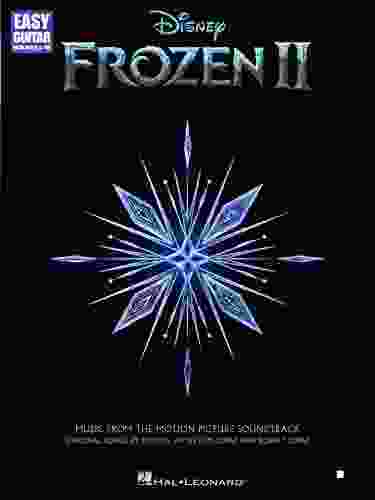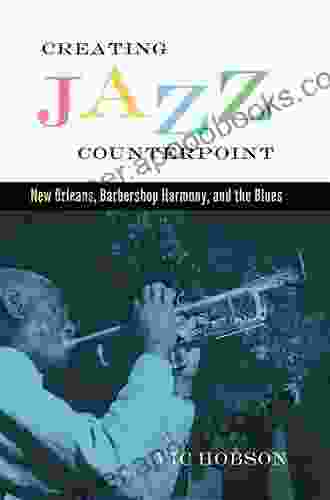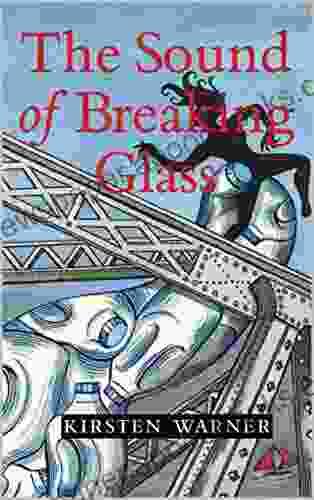Creating Jazz Counterpoint: The American Made Music Series

Jazz counterpoint is a powerful tool that can add depth and complexity to your jazz compositions. It's also a great way to improve your improvisation skills.
But what is jazz counterpoint, exactly? And how do you create it?
5 out of 5
| Language | : | English |
| File size | : | 4619 KB |
| Text-to-Speech | : | Enabled |
| Enhanced typesetting | : | Enabled |
| Word Wise | : | Enabled |
| Print length | : | 182 pages |
| Screen Reader | : | Supported |
| X-Ray for textbooks | : | Enabled |
In this article, we'll answer those questions and more. We'll start with a basic overview of jazz counterpoint. Then, we'll discuss some of the most common types of jazz counterpoint. Finally, we'll provide some tips for creating effective jazz counterpoint in your own compositions and improvisations.
What is Jazz Counterpoint?
Jazz counterpoint is the art of combining two or more independent melodic lines in such a way that they create a pleasing and coherent musical whole.
In jazz, counterpoint is often used to create tension and release. For example, a dissonant counterpoint line can be placed against a consonant melody line. This creates a sense of tension that can be resolved when the counterpoint line moves to a more consonant interval.
Counterpoint can also be used to create movement and interest in a composition. By using different rhythms and melodic contours in the different counterpoint lines, you can create a sense of forward motion.
Types of Jazz Counterpoint
There are many different types of jazz counterpoint. Some of the most common include:
- Linear counterpoint: This type of counterpoint is characterized by the use of independent melodic lines that move in parallel or contrary motion.
- Vertical counterpoint: This type of counterpoint is characterized by the use of chords and voicings to create harmonic tension and release.
- Modal counterpoint: This type of counterpoint is based on the use of scales and modes to create melodic and harmonic interest.
- Polyphonic counterpoint: This type of counterpoint is characterized by the use of multiple independent melodic lines that are played simultaneously.
Creating Effective Jazz Counterpoint
Creating effective jazz counterpoint is a skill that takes time and practice to develop. However, there are some general tips that can help you get started:
- Start with simple melodies: When you're first starting out, it's best to focus on creating simple melodic lines that are easy to follow.
- Use different rhythms and melodic contours: To create movement and interest in your counterpoint, use different rhythms and melodic contours in the different lines.
- Consider the harmonic implications: When you're creating counterpoint, it's important to consider the harmonic implications of the different melodic lines. Make sure that the lines create a pleasing and coherent harmonic whole.
- Practice, practice, practice: The best way to improve your jazz counterpoint skills is to practice regularly. Try writing counterpoint exercises or improvising with other musicians.
Jazz counterpoint is a powerful tool that can add depth and complexity to your jazz compositions and improvisations. By understanding the basic concepts of jazz counterpoint and practicing regularly, you can develop the skills you need to create effective and meaningful counterpoint in your own music.
If you're interested in learning more about jazz counterpoint, I encourage you to check out the following resources:
- JazzAdvice.com: Counterpoint in Jazz
- StudyBass.com: Jazz Counterpoint
- YouTube: Jazz Counterpoint Lesson
5 out of 5
| Language | : | English |
| File size | : | 4619 KB |
| Text-to-Speech | : | Enabled |
| Enhanced typesetting | : | Enabled |
| Word Wise | : | Enabled |
| Print length | : | 182 pages |
| Screen Reader | : | Supported |
| X-Ray for textbooks | : | Enabled |
Do you want to contribute by writing guest posts on this blog?
Please contact us and send us a resume of previous articles that you have written.
 Book
Book Novel
Novel Page
Page Chapter
Chapter Text
Text Story
Story Genre
Genre Reader
Reader Library
Library Paperback
Paperback E-book
E-book Magazine
Magazine Newspaper
Newspaper Paragraph
Paragraph Sentence
Sentence Bookmark
Bookmark Shelf
Shelf Glossary
Glossary Bibliography
Bibliography Foreword
Foreword Preface
Preface Synopsis
Synopsis Annotation
Annotation Footnote
Footnote Manuscript
Manuscript Scroll
Scroll Codex
Codex Tome
Tome Bestseller
Bestseller Classics
Classics Library card
Library card Narrative
Narrative Biography
Biography Autobiography
Autobiography Memoir
Memoir Reference
Reference Encyclopedia
Encyclopedia Ron Urick
Ron Urick George Herbert
George Herbert Teresa Maria O Hara
Teresa Maria O Hara Laura Neack
Laura Neack Kerri Maher
Kerri Maher T S Eliot
T S Eliot Glenn Beck
Glenn Beck John Lawrence
John Lawrence Howard Bryant
Howard Bryant Greg Sarris
Greg Sarris Goran Rodin
Goran Rodin Haekyung Um
Haekyung Um Tom King
Tom King Timesha Harris
Timesha Harris Robert H Anderson
Robert H Anderson George Paxinos
George Paxinos Ronnie Bachman
Ronnie Bachman Mitra Politi
Mitra Politi Laurence Shames
Laurence Shames Rhonda Bowen
Rhonda Bowen
Light bulbAdvertise smarter! Our strategic ad space ensures maximum exposure. Reserve your spot today!

 Jackson BlairAtlas of Metabolic Diseases Second Edition: A Landmark in Medical Literature
Jackson BlairAtlas of Metabolic Diseases Second Edition: A Landmark in Medical Literature Beau CarterFollow ·9.9k
Beau CarterFollow ·9.9k Craig BlairFollow ·5.5k
Craig BlairFollow ·5.5k Marcus BellFollow ·12k
Marcus BellFollow ·12k Craig CarterFollow ·4.3k
Craig CarterFollow ·4.3k Charles ReedFollow ·8.4k
Charles ReedFollow ·8.4k Al FosterFollow ·19.9k
Al FosterFollow ·19.9k Jack PowellFollow ·7.5k
Jack PowellFollow ·7.5k George R.R. MartinFollow ·16k
George R.R. MartinFollow ·16k

 Ken Follett
Ken FollettDiscover the Enchanting World of Classical Piano with "10...
A Symphony of Timeless...

 Cody Russell
Cody RussellTheo On The Ice Boston Bay Vikings: A Hockey Adventure...
Theo On The Ice...

 Nathaniel Hawthorne
Nathaniel HawthorneBach for Easy Guitar: Unleash the Genius of the Baroque...
Johann Sebastian Bach, the undisputed...

 Brenton Cox
Brenton CoxAfrican Recipes For Every Concern: Delicious,...
Embark on a Culinary Journey to the Heart of...

 Lawrence Bell
Lawrence BellEasy Guitar With Notes Tab: Your Ultimate Guide to...
Unlock the World...

 Brenton Cox
Brenton CoxCarter On The Ice: A Thrilling Sports Novel
Synopsis ...
5 out of 5
| Language | : | English |
| File size | : | 4619 KB |
| Text-to-Speech | : | Enabled |
| Enhanced typesetting | : | Enabled |
| Word Wise | : | Enabled |
| Print length | : | 182 pages |
| Screen Reader | : | Supported |
| X-Ray for textbooks | : | Enabled |










